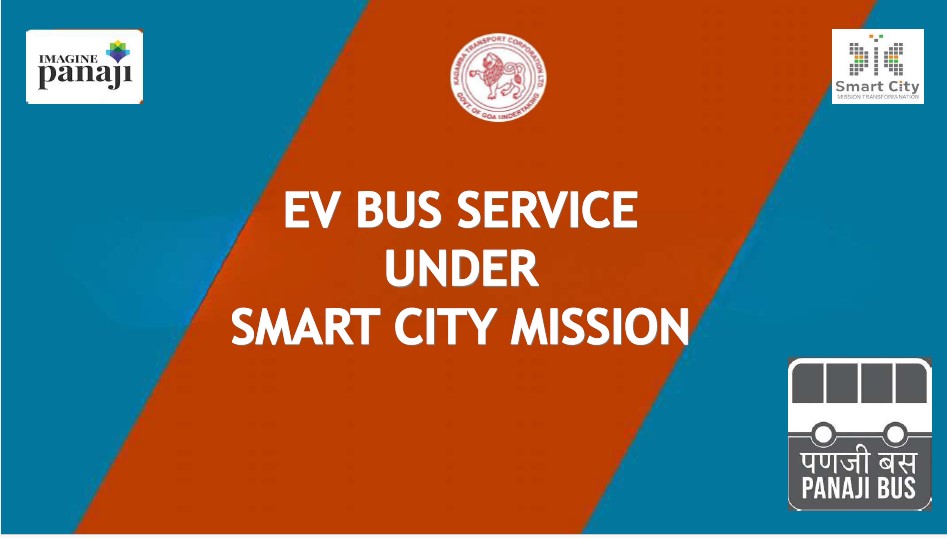Panaji’s Smart City E-Bus Initiative Registers Impressive Growth in Ridership, Revenue and Digital Adoption
(Panaji, 29th April, 2025): The Panaji Smart City E-Bus project has emerged as a successful model for sustainable and digitally empowered urban transportation. Under the Smart Public Transit initiative, a total of 48 electric buses — ranging from 12-meter to 7-meter variants — have been deployed across key locations in Panaji. These buses operate on seven high-frequency loop routes covering prominent areas such as Central Panaji, Mala, Bhatlem, Altinho, Taleigao, St. Cruz, Bambolim, Dona Paula and Cujira. Supporting this transition to electric mobility are ten strategically placed charging stations at Porvorim (8) and Campal (2), along with a smart transit card and digital ticketing app that facilitate seamless commuting.
From July 2024 to March 2025, over 16.92 lakh passengers utilized the E-Bus services, covering a total of 8.77 lakh kilometers. Revenue increased from ₹6.49 lakh in July 2024 to ₹27.24 lakh in March 2025. The system has significantly contributed to sustainability, cutting 66.5 tons of CO₂ emissions per month. A total of 19,533 smart cards have been issued by KTCL and IPSCDL, emphasizing the growing shift toward cashless, tech-enabled mobility.
The transformation of four major routes into conductor-less corridors has played a pivotal role in driving digital adoption.
On the Red Route (Panjim Market, Taleigao, Dona Paula, Panaji Bus Stand), where three of six buses operate without conductors, digital revenue rose from ₹14,892 in January 2025 to ₹60,131 in March 2025 — a 304% increase. Passenger count also saw a 33% rise from February to March 2025 (from 7,858 to 10,429). The EPKM for the month of March 2025 was ₹10.
The Indigo Route (Bhatlem, St. Cruz) showed improved performance, with digital revenue rising from ₹77,896 in February 2025 to a staggering ₹156,304 in March 2025. Despite temporary road closures affecting the route, passenger numbers increased from 8,612 in February 2025 to 16,420 in March 2025. The EPKM for March 2025 stood at ₹8.
The Orange Route (Mala, Taleigao) displayed consistent growth, with digital revenue rising to ₹1,28,274 in March 2025. Passenger numbers increased from 11,591 in February 2025 to 12,065 in March 2025, while the EPKM for March 2025 stood at ₹11.
The Green Route (Altinho, Church Square) maintained solid numbers, with an EPKM of ₹13 for the month of March 2025 and steady digital revenue growth post-implementation of the conductor-less model.
Meanwhile, routes still operating with onboard conductors also demonstrated encouraging trends.
The Yellow Route (Miramar, Dona Paula, Bambolim), with 10 buses, saw digital revenue grow from ₹10 in July 2024 to ₹205,689 in March 2025. Passenger volume surged from 49,316 in July to 123,882 in March, totaling 9.3 lakh riders overall. This route recorded EPKM of ₹28 for the month of March 2025.
The Blue Route (Central Panaji), served by 5 buses, recorded a rise in digital revenue from ₹960 in August 2024 to ₹51,662 in March 2025. Passenger numbers grew from 4,556 to 25,228 during the same period, with a total ridership of 1.82 lakh and an EPKM of ₹18 for the month of March 2025.
The Violet Route (Mala, St. Inez), with 6 buses, saw its digital revenue increase from ₹60 in August 2024 to ₹83,758 by March 2025. Passenger traffic grew from just 462 to 35,602 in the same span, with a total of 2.01 lakh passengers and an EPKM of ₹15 for the month of March 2025.
The remaining part of the Red Route (Panjim Market, Taleigao, Dona Paula, Panaji Bus Stand), where 3 buses are still operated with conductors, showed steady digital growth from ₹530 in August 2024 to ₹41,119 in March 2025. Ridership increased from 5,938 to 17,685, with total passengers exceeding 1.12 lakh and an EPKM of ₹13 for the month of March 2025.
Commenting on the progress, Mr. Sanjit Rodrigues, CEO & MD , IPSCDL said, “Panaji is embracing a cleaner, smarter and more connected future. The public’s response to electric buses and digital payments has exceeded expectations, paving the way for a scalable model for other cities.”
Looking forward, the Panaji Smart City team plans to expand conductor-less services, upgrade digital ticketing systems and integrate last-mile electric mobility to further enhance the urban commuting experience




